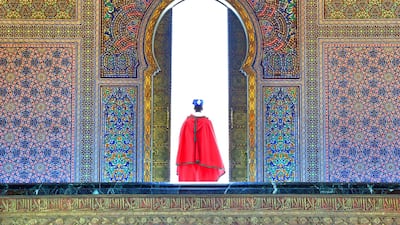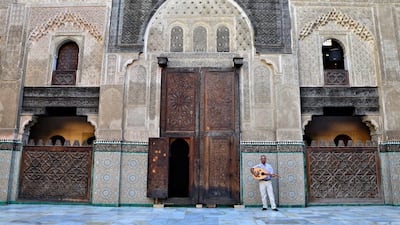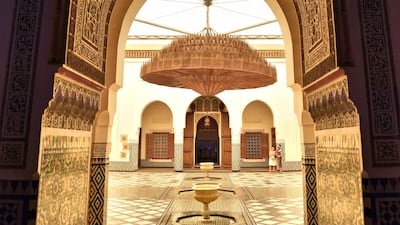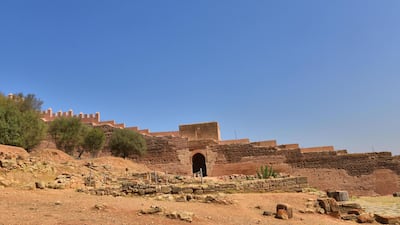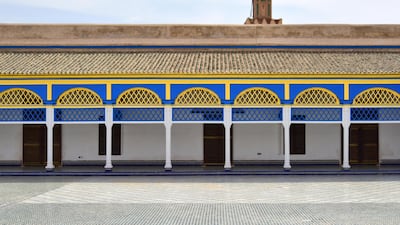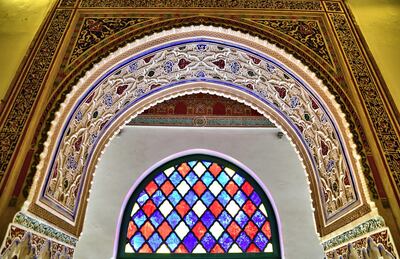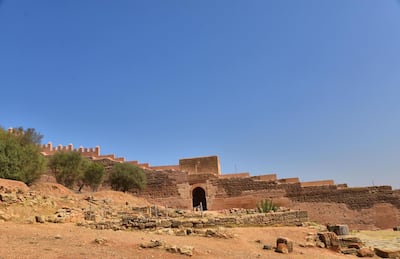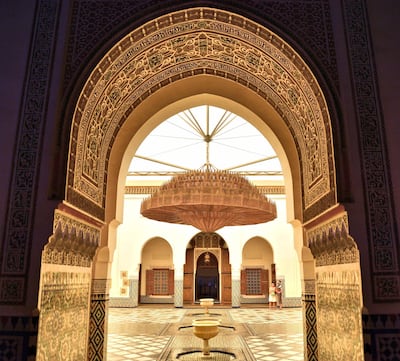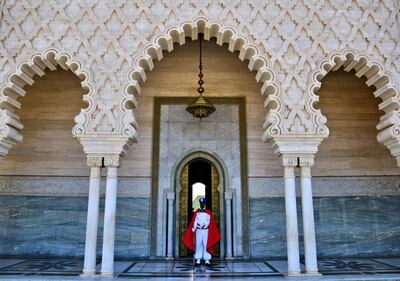They house royalty, taught generations about Islam, influenced Muslim architecture worldwide, survived pandemics and wars, and hide incredible stories behind their glorious facades.
Morocco boasts some of the world’s most beautiful examples of Islamic architecture. From a giant necropolis and a stunning mausoleum to an ancient Islamic college, here are five of Morocco’s most extraordinary structures.
Bahia Palace, Marrakech
As I strain my neck to stare up at the ceiling, I almost feel dizzy. Not due to my posture, but rather because of the mesmerising patterns painted on the wooden surface above me. This dense mixture of geometric and floral motifs is called zouak, a type of hand-painted design seen in mosques, mansions and palaces across Morocco. It is used liberally on the ceilings, doors and window frames in Bahia Palace.
An army of artisans from across Morocco needed 14 years to create this grand complex. Blending Andalusian and Moroccan architectural elements, Bahia Palace is not just beautiful, but also eclectic in appearance. From candy-striped surfaces to intricate stonework, giant marble courtyards and the rainbow palettes of stained-glass windows, every corner has interesting elements.
Just as remarkable as these aesthetics is the story of the man Bahia was built for in the early 1800s. A slave who worked his way up into the royal staff, became head of house, then a royal adviser and, finally, a kingmaker, Si Moussa is an important figure in Moroccan history.
Bou Inania Madrasa, Fez
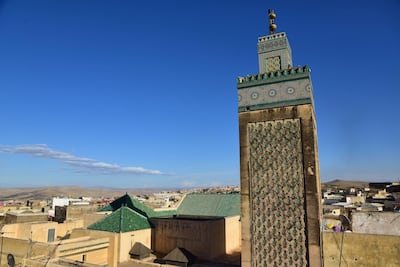
It is not simple to stand out in the medina of Fez, a labyrinth of more than 9,000 narrow streets and alleys lined with endless examples of graceful Moroccan architecture. Which is why towering above this urban maze is the best way to get noticed. That is just what Bou Inania Madrasa does, thanks to its lofty minaret, which is covered in gleaming turquoise mosaics made from traditional Moroccan zellige tiles.
Down below the tower, this ancient Islamic college is equally astonishing. Built by the Marinid dynasty, in the 1350s, it was one of the city’s main centres for teaching young men about the Quran, as well as Arabic literature, mathematics and Islamic law.
Students would have done well to concentrate on these subjects given the distracting opulence of their surroundings. Bou Inania is built around a central, marble-floored courtyard. The walls of this space are embellished by intricately carved cedar lattices, gorgeous stonework and complex stucco designs. All of this combines to create a visual spectacle that is overwhelming in the finest possible way. This is a not a building easily forgotten.
Chellah, Rabat
Just beyond the hubbub of downtown Rabat, a long stone wall runs down a gently sloping hillside. While parts of it are now crumbled, this fortification once protected not a single building, but rather an extraordinary Islamic necropolis. Collectively, the ancient remains of Chellah – a mosque, royal mausoleums, towering gateways and an Islamic academy – form one of Morocco’s most inspiring architectural complexes.
This is what’s left of a necropolis, a burial complex for high-ranking members of the Marinid dynasty, which ruled swathes of Morocco between the 1200s and 1400s. But archaeologists have also found signs that 2,000 years ago, Chellah was a city populated first by the Phoenicians and then the Romans.
Tourists can wander every part of this historic site, weaving past weathered Roman columns, ancient Phoenician homes, a towering Islamic minaret and the ruins of an Islamic college. That last site is alongside the tomb of the most famous Marinid sultan, Abu al-Hasan, who led an expansion of that dynasty’s domain. All of this is accessed by passing through a commanding stone and wood gateway that’s long been the entrance point to Chellah.
Marrakech Museum, Marrakech
The main museum of the city of Marrakech displays some of Morocco’s most important artefacts, including artworks that are up to 1,000 years old. Yet these priceless items, at times, are upstaged by the lavish design of this museum, which is housed in the former Mnebhi Palace.
This ostentatious mansion, built in the early 1900s, is connected by a sequence of beautiful courtyards. One is an open-air space with turquoise floor tiles, whitewashed walls and multicoloured clay torches. The main courtyard, meanwhile, is dominated by an enormous, oval-shaped wooden lamp that looms like an ornate spaceship slowly descending to Earth.
Spoking off from this courtyard are many intimate spaces – former bedrooms and dining rooms – which showcase both historic and contemporary Moroccan art. There’s also an impressive weaponry room, where ancient swords and daggers hang from forest-green walls, above which are ceilings decorated with layer upon layer of intricate, hand-carved wooden patterns.
Mausoleum of Sultan Mohammed V, Rabat
This is one of the most photogenic structures I’ve ever seen. It wasn’t until I got back to my hotel, after visiting Rabat’s phenomenal Mausoleum of Sultan Mohammed V, that I realised I’d taken more than 100 photos of the building. It is a suitably stately home for the tomb of the father and grandfather of the current King of Morocco, Mohammed VI. Unlike the other structures on this list, this mausoleum is not ancient, having been built just 50 years ago.
The use of repetitive patterns in and around the mausoleum is truly hypnotic. These geometric designs adorn the stone floors that surround the structure, as well as the cream facade of the mausoleum, its deep-green roof, and its interior walls, arches, doors and ceiling.
Colossal chandeliers illuminate the mausoleum within, each exit of which is protected by a Moroccan Royal Guard.
With their white suits, blue caps and long red capes, these spiffy soldiers add to the regal feel of the site. The mausoleum sits opposite another important piece of Islamic architecture, the 44-metre-tall Hassan Tower, built in the late 12th century as the minaret of what had been planned to be the world’s second largest mosque.
